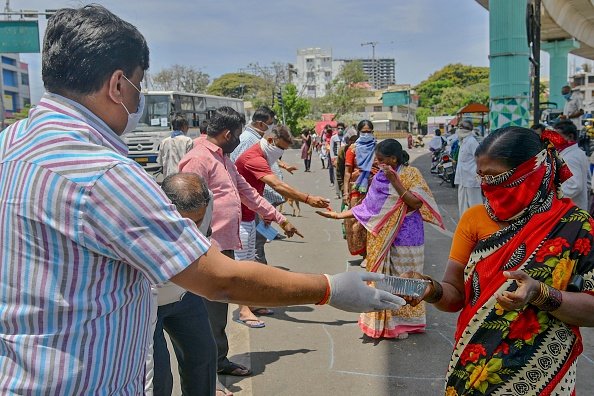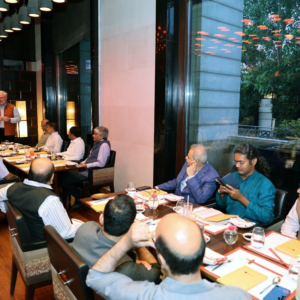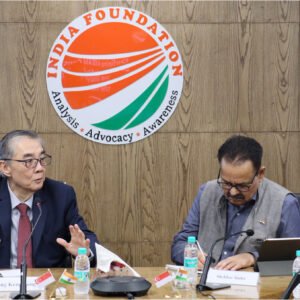At the time of writing, the world is facing a pandemic from Covid-19 that was first discovered in November 2019 in the city of Wuhan in China. By March 2020, many of the world’s governments announced lockdowns to curb the spread of the SARS-CoV-2 virus which caused Covid-19. As of 20 June 2021, over 176 million people around the world have been affected by the virus, and over thirty-seven lakh lives lost – even after sound medical care in many cases. India experienced a ‘second wave’, despite a robust vaccination program, in April 2021 when it reported over one lakh cases a day. With its vast population, the country has, in the second wave, both the maximum number of new cases and deaths. Although the number of new cases by end June have drastically reduced, the pandemic is far from over.
As demonstrated by this pandemic, the question is not “if” a country will be affected but rather “when”. It is believed that developing countries are more vulnerable and that pandemics strike hardest at the most marginalised, the poorest and the most vulnerable groups as they lack the awareness and preparedness to deal with a pandemic.
This article explores the contribution of Non Governmental Organisations (NGOs) during the pandemic in India. In order to do so, the article first discusses the role of NGOs in pandemic preparedness and then gives examples of contributions of various NGOs in India.
The Role of NGOs in Pandemic Preparedness
With increases in population and skewed concentration of people in urban areas, it is argued that NGOs “have the opportunity and the responsibility to play a major role in preparedness, response, impact mitigation and advocacy to lessen the consequences”[i] of a pandemic, particularly amongst the poor and vulnerable groups. NGOs have the required presence, skill and experience to be able to contribute during pandemic planning and response. In particular, scholars believe that NGOs can contribute most in areas of health, economic aid, education and community-based surveillance.
The World Health Organisation (WHO) issued ten ‘Guiding Principles for International Outbreak Alert and Response’ in 2009, that state how nations must respond to outbreaks of international importance, including pandemics, and how to coordinate efforts between parties on field. Of importance is guiding principle number seven that outlines the role of NGOs. It states, “There is recognition of the unique role of national and international non-governmental organisations (NGOs) in the area of health, including in the control of outbreaks. NGOs providing support that would not otherwise be available, particularly in reaching poor populations”[ii].
The scientific community agrees on four ways to reduce the effects and spread of any pandemic—vaccination, antiviral drug use, medical care and public health systems. Here, NGOs can contribute on-ground towards both prevention and preparedness through information dissemination, education, and community-based health care drives. On a policy level, they can inform decisions through surveillance, and by identifying and reporting potential ‘hotspots’ such as slums, high density residential colonies, or poorly ventilated areas. They can also bridge the gap between governments and international bodies such as the WHO that typically monitor pandemics. More importantly, they can bridge the gap between governments and citizens and are better placed to identify the needs of a community, including those that are hard to reach. Finally, NGOs can employ their networks, to share and amplify information.
In the very first week of lockdown in March 2020 in India, Prime Minister Narendra Modi called on NGOs to help the government in dealing with the pandemic[iii]. He urged them to provide basic necessities to the underprivileged such as medical and protective gear and more importantly to spread information on awareness campaigns such as washing hands, wearing masks and maintaining social distancing. The NITI Aayog too, reached out to over 92,000 NGOs during the first few months of the onset of the pandemic to “boost cross-sectoral collaboration”[iv] and exploit NGOs network to ensure effective distribution of essentials. More importantly, they needed help in spreading awareness among the rural population to educate them on Covid-19, on techniques to identify the virus, the precautionary measures that should be taken and when to seek medical care.
During the Covid-19 pandemic, many NGOs used social network platforms like Instagram, Facebook and Twitter to share and amplify information regarding vaccination centres, vaccine availability, vaccine safety, and to help individuals in need of oxygen, blood or a hospital bed. NGOs also used their network to bring doctors together on online platforms, to provide free medical advice to those affected by Covid-19.
Examples of contribution of NGOs in India
Over 90,000 NGOs were contacted by NITI Aayog to help the government in dealing with the Covid-19 pandemic. Every NGOs contribution is significant, no matter how big or small. It is beyond the scope of this paper to examine the contribution of every NGO. Therefore, it looks at a select few as examples of the role of NGOs and their contribution during the pandemic, through activities such as distribution of food and essential supplies, blood donation and plasma donation drives, support groups and raising awareness.
Rashtriya Sewa Bharati
The Rashtriya Sewa Bharati conducted several large scale, nationwide activities to support communities during Covid-19. The organisation was inspired by the acts of humanity by social reformers such as Swami Vivekananda, and under different state units, carried out Covid-19 relief efforts[v]. It mobilised over half a million volunteers and served at 92,656 towns across India[vi]. Among its various activities, it distributed food and food supplies to over seven million families, and food packets to 45 million people[vii]. This is perhaps the largest outreach programme conducted during a pandemic in India. Apart from food, the volunteers also distributed over nine million masks and donated more than 60,000 units of blood. The volunteers even helped over 44 lakh migrant workers, an oft forgotten, under represented and vulnerable group, since the first lockdown in India in March 2020. These migrants come from across the country and many were stranded or left with few opportunities to return to their hometowns. The Rashtriya Sewa Bharati set up over 400 medical centres across the country for migrants. In addition, they created over 900 help centres at bus stations and railways stations in India to help the migrants return to their hometowns. They also actively helped to secure jobs for the migrant workers once lockdown was lifted[viii].
Another activity that was conducted under Covid-19 relief was the restoration of old and unused hospitals into Covid-19 centres. One such example is the Bharat Gold Mines Limited (BGML) hospital in Kolar, Karnataka that was unused for nearly twenty years[ix]. A group of 300 volunteers from the organisation came together to restore the hospital and cleared it of weeds, debris and cobwebs. Within two weeks, a 300-bed hospital was set up, equipped with oxygen facility[x]. The organisation also formed a ‘Covid Response Team’ (CRT) dedicated towards aid and relief during the pandemic. The CRT created a helpline along with volunteers and over hundred doctors. In just over a month, the helpline had received 88,000 calls[xi]. The organisation also conducted health camps across Chennai, Bengaluru, Gorakhpur and Pune, among other cities as mentioned in Akhil Bharatiya Annual Report[xii]. The organisation was able to modify its programmes to suit the needs of the pandemic. For instance, in 2020, the focus was on helping migrant workers by providing them with food and safety, while in 2021 the focus shifted towards medical assistance—procuring oxygen, hospital beds, donating plasma, and conducting cremations.
The Hemkunt Foundation
Another NGO, the Hemkunt Foundation based in New Delhi, provided over 360 tons of meals to migrant workers. The NGO grew to international recognition during the second Covid-19 wave for its efforts in organising oxygen, medicines and hospital beds for those in need[xiii]. The organisation is based in New Delhi, which was badly affected during the second wave of the pandemic. The NGO, working out of makeshift camps in Gurgaon, provided oxygen through cars. They also created a facility with 700 medical beds, a fleet of ambulances, and distributed food to families affected by the virus. At the peak of the second wave, the Foundation even provided oxygen to hospitals in need, and launched a “drive through” oxygen initiative to provide oxygen to patients inside their cars[xiv]. The Foundation operates through over 100 volunteers and has 5,000 donors globally, a lot of whom donated through various social media campaigns. The money raised was used toward Covid-19 relief.
CRY
Child Rights and You (CRY) is another NGO that did extensive work during the pandemic. Founded in 1979 in Delhi, the NGO focuses its attention on an oft neglected group—young children. The organisation partners with other local NGOs to provide its services, ranging from basic health and hygiene kits for children to cooked meals every day. They paid particular focus to abandoned children and those that were left as orphans due to the deadly pandemic. To raise awareness about Covid-19 they conducted home visits for those without a phone, maintaining all social distancing protocols, and released campaigns through phone calls and WhatsApp including videos on how to wash hands. These campaigns revolved around public health and hygiene and behaviour change, sanitisation, and the proper use of face masks. Since the closure of government schools, and consequently the mid-day meal programme, many children were unable to get proper nutrition and timely immunisation. The organisation raised money to feed children, and also created programmes that focused on the psychological well-being of children, particularly for those who had not attended school due to the pandemic. In 2020-21, CRY was able to impact over six lakh children through their various programmes[xv]. By focusing their attention on vulnerable children, the organisation helped ensure that the pandemic does not leave a trail of child rights crisis in the long term.
ISKCON
The International Society for Krishna Consciousness (ISKCON), founded in 1966 in New York has grown in presence across the world. Through their network of temples and rural communities, hundreds of affiliated vegetarian restaurants, and thousands of local meeting groups, they were able to carry out impressive work during the pandemic. During the on-going ‘second wave’ of the pandemic in India, ISKCON set up a fully functional, free facility with 200 beds, ten doctors and 18 nurses at Dwarka, New Delhi. The temporary facility included an ICU and ventilator facility, and patients were given nutritious meals. Apart from the hospital facility, ISKCON was already engaged in delivering free, safe and hygienic food to COVID patients at their doorstep under the ‘ISKCON Food Relief Initiative’. During the pandemic, 140 million plates of food were served through 77 kitchens spread across the country—perhaps one of the biggest such initiatives in the country. These meals were served to those stranded without support at home, to those forced to maintain social distancing within their homes, to entire families affected by coronavirus, to daily wage workers, low-income families and migrant workers. The vision of ISKCON during the pandemic was that “no one within a 10-mile radius of its centre should go hungry, which is even truer in today’s context”[xvi]. Food insecurity is an even bigger issue during a pandemic, particularly for those who cannot afford to ‘stock pile’. To address this challenge, on every day of the pandemic, hundreds of monks and volunteers prepared fresh food and delivered it to to the doorsteps of those in need, apart from setting up temporary food camps across cities in India. By partnering with government agencies, ISKCON was able to identify areas that were most in need of such food camps.
Green Dream Foundation
The Green Dream Foundation, a smaller NGO in size than others on this list, mainly deals with environmental issues but tweaked their programmes to help during the pandemic. At the onset of the pandemic, the Foundation, along with a few IIT graduates, started COVID SOS, a platform to help senior citizens and physically challenged people. Using WhatsApp and GPS technology they could find volunteers within walking distance of the person in need. Volunteers performed errands for those who could not leave their homes and also supplied emergency services and equipment and essentials. The platform has over a thousand volunteers across 10 cities.
Others
Some NGOs work in focus areas or limited locations and are not spread across the country. These NGOs are better suited to serve the needs of the communities they work with. One such NGO is The Enrich Lives Foundation, formerly known as The Annapurna Movement. It works in and around Mumbai, Maharashtra, with a special focus on its slums. The NGO, founded during the first wave of Covid-19 in March 2020, works with the express aim of aiding those in need affected by the pandemic. They put special focus on women, nutrition and public health. The Enrich Lives Foundation distributed food grains and grocery (ration) kits, and also helped those who lost work due to the pandemic to regain employment. The ration kits included wheat, rice, oil and pulses. During the pandemic they distributed over 10 lakh meals, over 30,000 ration kits, and Covid-19 relief material such as masks and sanitisers, worth rupees five crore. They raised funds mainly through online platforms like Ketto and Give India.
Not strictly started as NGOs but worth a mention is the contribution of some individuals with tremendous social media influence who have helped in Covid-19 relief either directly or by channelling funds through NGOs or by amplifying messages and the work of various NGOs. One such person is Bollywood actor Sonu Sood, who is considered by many to be at the forefront of charity work during the pandemic. He was instrumental in setting up oxygen plants in places like Kurnool and Nellore, both in Andhra Pradesh, that catered to government hospitals. His team also distributed over 700 oxygen concentrators to patients undergoing Covid-19 home treatment, and also created a shot video to raise awareness on India’s vaccination programme. Today, he channels his Covid-19 relief efforts through his newly created Sood Foundation.
Conclusion
The importance of NGOs cannot be underestimated for five main reasons. First, they intimately understand community needs and are better placed to help during a pandemic. NGOs work with a range of vulnerable populations, possess a deep understanding of their needs, have rapports with the communities for years and are more suited to be the first point of contact and help during a pandemic. Second, NGOs have the ability to adapt to pandemic constraints, enabling them to continue supporting vulnerable populations. They can also tweak their existing programmes to suit the needs of the pandemic and to suit the community context. Third, NGOs play a pivotal role in raising awareness and educating the public about Covid-19 as they can use the networks of trust they have built, within the communities they work with. They can do this through effective on-ground programmes, text messages, WhatsApp and social networks. This is particularly useful in raising awareness of the importance of vaccinations. Four, NGOs can customise their outreach programmes to suit the needs of the local communities they serve. This puts NGOs in a unique position unlike government programmes that have a ‘one size fits all’ approach. Five, NGOs can step in when governments cannot, and can provide services that governments do not. In the case of Covid-19 and the present pandemic, masks, soap, water and sanitisers are essentials. Most of these ‘essentials’ are unaffordable to many sections of the population. Although the government advisories require wearing of masks, how many are in a position to afford them? In cases like this NGOs can step in to distribute masks for free to those who cannot afford them. The above examples throw light on how NGOs have done this. Finally, the biggest constraint that any NGO faces is in raising money to carry out their activities. Here, the public and donations from large organisations come handy. During this pandemic, we witnessed large and genuine outreach programmes to raise money for Covid-19 relief that NGOs of all scales and sizes, were able to channel towards relief programmes.
Author Brief Bio: Shreya has completed her masters in development from the Institute of Development Studies, UK. She has previously been associated with ORF and is currently a Senior Research Fellow at India Foundation.
[i] Mahmood, Jemilah (2009). ‘The Role of Non-Governmental Organizations in Pandemic Prepardness’ S Rajaratnam School of International Studies https://www.jstor.org/stable/pdf/resrep05905.21.pdf?ab_segments=0%252Fbasic_search_gsv2%252Fcontrol&refreqid=excelsior%3A49565b3320e90dd6690f94bc7c00cf83
[ii] Giorgetti, Chiara (2010). The Principled Approach to State Failure: International Community Actions in Emergency Situations. Page 95, accessed via Google Books.
[iii] Indian Express 2020. https://indianexpress.com/article/india/crime/coronavirus-india-lockdown-help-govt-serve-poor-pm-modi-to-ngos-6339236/
[iv] Times of India 2020. https://government.economictimes.indiatimes.com/news/governance/civil-society-the-third-pillar-of-strength-in-fight-against-coronavirus/75642349
[v] https://www.rashtriyasewabharati.org/
[vi] https://www.prnewswire.com/news-releases/rss-annual-report-reflects-a-year-of-pandemic-related-service-across-india-301253050.html
[vii] Ibid
[viii] https://indianexpress.com/article/india/rss-in-the-time-of-covid-from-plasma-donation-to-conducting-last-rites-6548122/
[ix] https://www.indiatoday.in/india-today-insight/story/how-the-rss-s-covid-relief-campaign-is-helping-thousands-1805971-2021-05-23
[x] Ibid
[xi] https://www.indiatoday.in/india-today-insight/story/how-the-rss-s-covid-relief-campaign-is-helping-thousands-1805971-2021-05-23
[xii] https://www.rss.org/Akhil%20Bharatiya%20%20Annual%20Report%202021%20English.pdf
[xiii] https://qz.com/india/2008877/how-hemkunt-foundation-helped-10000-indians-during-oxygen-crisis/
[xiv] https://qz.com/india/2008877/how-hemkunt-foundation-helped-10000-indians-during-oxygen-crisis/
[xv] https://www.cry.org/protect-children-in-covid-world-resilience-recovery/
[xvi] http://iskconfoodrelief.com/




